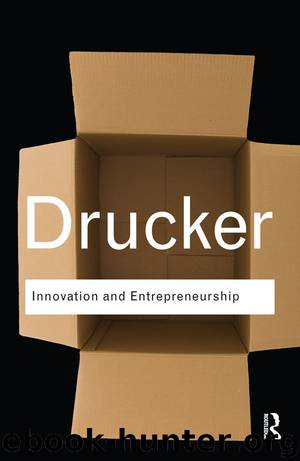Innovation and Entrepreneurship (Routledge Classics) by Peter Drucker

Author:Peter Drucker
Language: eng
Format: mobi
ISBN: 9781317601357
Publisher: Taylor and Francis
Published: 2014-09-14T14:00:00+00:00
III
The Don’ts
And now the few important ‘don’ts’.
1. The first is simply not to try to be clever. Innovations have to be handled by ordinary human beings, if they are to attain any size and importance at all, by morons or near-morons. Incompetence, after all, is the only thing in abundant and never-failing supply. Anything too clever, whether in design or execution, is almost bound to fail.
2. Don’t diversify, don’t splinter, don’t try to do too many things at once. This is, of course, the corollary to the ‘do’: be focused! Innovations that stray from a core are likely to become diffuse. They remain ideas and do not become innovations. The core does not have to be technology or knowledge. In fact, market knowledge supplies a better core of unity in any enterprise, whether business or public-service institution, than knowledge or technology do. But there has to be a core of unity to innovative efforts or they are likely to fly apart. An innovation needs the concentrated energy of a unified effort behind it. It also requires that the people who put it into effect understand each other, and this, too, requires a unity, a common core. This, too, is imperiled by diversity and splintering.
3. Finally, don’t try to innovate for the future. Innovate for the present! An innovation may have long-range impact; it may not reach its full maturity until twenty years later. The computer, as we have seen, did not really begin to have any sizeable impact on the way business was being done until the early 1970s, twenty-five years after the first working models were introduced. But from the first day the computer had some specific current applications, whether scientific calculation, making payroll, or simulation to train pilots to fly airplanes. It is not good enough to be able to say, ‘In twenty-five years there will be so many very old people that they will need this.’ One has to be able to say, ‘There are enough old people around today for this to make a difference to them. Of course, time is with us – in twenty-five years there will be many more.’ But unless there is an immediate application in the present, an innovation is like the drawings in Leonardo da Vinci’s notebook – a ‘brilliant idea’. Very few of us have Leonardo’s genius and can expect that our notebooks alone will assure immortality.
The first innovator who fully understood this third caveat was probably Edison. Every other electrical inventor of the time began to work around 1860 or 1865 on what eventually became the light bulb. Edison waited for ten years until the knowledge became available; up to that point, work on the light bulb was ‘of the future’. But when the knowledge became available – when, in other words, a light bulb could become ‘the present’ – Edison organized his tremendous energies and an extraordinarily capable staff and concentrated for a couple of years on that one innovative opportunity.
Innovative opportunities sometimes have long lead times.
Download
This site does not store any files on its server. We only index and link to content provided by other sites. Please contact the content providers to delete copyright contents if any and email us, we'll remove relevant links or contents immediately.
Pioneering Portfolio Management by David F. Swensen(6083)
Man-made Catastrophes and Risk Information Concealment by Dmitry Chernov & Didier Sornette(5654)
Zero to One by Peter Thiel(5495)
The Motivation Myth by Jeff Haden(5007)
The Miracle Morning by Hal Elrod(4424)
Elon Musk by Ashlee Vance(3860)
The Art of Persistence: Stop Quitting, Ignore Shiny Objects and Climb Your Way to Success by Michal Stawicki(3573)
Unlabel: Selling You Without Selling Out by Marc Ecko(3473)
Delivering Happiness by Tony Hsieh(3284)
Urban Outlaw by Magnus Walker(3244)
Purple Cow by Seth Godin(3073)
Mastering Bitcoin: Programming the Open Blockchain by Andreas M. Antonopoulos(2894)
The Marketing Plan Handbook: Develop Big-Picture Marketing Plans for Pennies on the Dollar by Robert W. Bly(2797)
The Power of Broke by Daymond John(2779)
The Content Trap by Bharat Anand(2779)
Applied Empathy by Michael Ventura(2753)
The Airbnb Story by Leigh Gallagher(2703)
Keep Going by Austin Kleon(2598)
Radical Candor by Kim Scott(2584)
